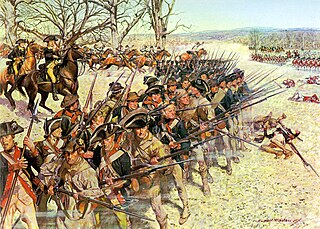 W
WThe 1st Maryland Regiment originated with the authorization of a Maryland Battalion of the Maryland State Troops on 14 January 1776. It was organized in the spring at Baltimore, Maryland and Annapolis, Maryland under the command of Colonel William Smallwood consisting of eight companies and one light infantry company from the northern and western counties of the colony of Maryland.
 W
WThe 1st Rhode Island Regiment was a regiment in the Continental Army raised in Rhode Island during the American Revolutionary War (1775–83). It was one of the few units in the Continental Army to serve through the entire war, from the siege of Boston to the disbanding of the Continental Army on November 3, 1783.
 W
WThe 1st Virginia Regiment was an infantry regiment of the Virginia Line that served with the Continental Army during the American Revolutionary War.
 W
WThe 2nd Canadian Regiment (1776–1783), also known as Congress' Own or Hazen's Regiment, was authorized on January 20, 1776, as an Extra Continental regiment and raised in the province of Quebec for service with the American Continental Army under the command of Colonel Moses Hazen. All or part of the regiment saw action at Staten Island, Brandywine, Germantown and the Siege of Yorktown. Most of its non-combat time was spent in and around New York City as part of the forces monitoring the British forces occupying that city. The regiment was disbanded on November 15, 1783, at West Point, New York.
 W
WThe 2nd Pennsylvania Regiment, formed with lauded veterans from the 1st Pennsylvania Battalion, was raised in December 1776.
 W
WThe 6th Maryland Regiment, active from 27 March 1776—January 1, 1783, is most notable for its involvement during the American Revolutionary war of the same years. An infantry type regiment consisting of 728 soldiers, the 6th Maryland was composed of eight companies of volunteers from Prince Georges, Queen Anne's, Fredric, Cecil, Harford, and Ann Arundel counties in the colony of Maryland
 W
WThe 6th Massachusetts Regiment also known as the 4th Continental Regiment was raised on April 23, 1775, under Colonel John Nixon outside of Boston, Massachusetts. The regiment would see action at the Battle of Bunker Hill, New York Campaign, Battle of Trenton, Battle of Princeton and the Battle of Saratoga. The regiment was furloughed June 12, 1783, at West Point, New York and disbanded on November 3, 1783.
 W
WThe 7th Maryland Regiment was authorized on 16 September 1776, for service with the Continental Army and was assigned on 27 December 1776. The regiment was composed of eight companies of volunteers organized from Frederick and Baltimore counties of the colony of Maryland.
 W
WIn October 1774, Jedediah Huntington of Norwich was made Colonel of the 20th Regiment of Connecticut Militia. When news of the Battles of Lexington and Concord arrived in Norwich on April 20, 1775 Colonel Huntington immediately got his men ready to march. On April 26 they arrived in Wrentham, Massachusetts, and a few days later they were in Roxbury and became part of the Siege of Boston. Because of a lack of overall command, as well as a lack of supplies, many of the militia units returned home.
 W
WThe American Legion was a provincial cavalry and infantry corps (regiment) of the British Army in the American War of Independence commanded by Brigadier General Benedict Arnold.
 W
WThe Commander-in-Chief's Guard, commonly known as Washington's Life Guard, was a unit of the Continental Army that protected General George Washington during the American Revolutionary War. Formed in 1776, the Guard was with Washington in all of his battles. It was disbanded in 1783 at the end of the war.
 W
WThe Continental Marines were the amphibious infantry of the American Colonies during the American Revolutionary War. The Corps was formed by the Continental Congress on November 10, 1775 and was disbanded in 1783. Their mission was multi-purpose, but their most important duty was to serve as onboard security forces, protecting the captain of a ship and his officers. During naval engagements Marine sharpshooters were stationed in the fighting tops of the ships' masts, they would also man the cannons along with the crew of the ship and were supposed to shoot the opponent's officers, naval gunners and helmsmen.
 W
WThe King's Orange Rangers, also known as the Corps of King's Orange Rangers, were a British Loyalist battalion, raised in 1776 to defend British interests in Orange County, Province of New York and generally in and around the New York colony, although they saw most of their service in the Province of Nova Scotia. The battalion's commander was Lieutenant Colonel John Bayard. The Rangers had an undistinguished military record, through most of its existence, and saw very limited combat, mostly against Patriot privateers, but did play an important role in the defence of the colony of Nova Scotia in the later years of the American Revolution. The King's Orange Rangers are especially remembered for their role in the defence of Liverpool, in the Nova Scotia colony.
 W
WThe 5th Hussar Regiment was a French Hussar regiment.
 W
WThe Westminster Dragoons (WDs) was a yeomanry regiment of the British Army Army Reserve, located in central London. Its lineage is continued by one of the Royal Yeomanry's six squadrons. Formed in the aftermath of Second Boer War as part of the County of London Yeomanry, the WDs fought in the Battle of Gallipoli and led British forces onto the beaches during the Normandy Invasion in 1944. The squadron most recently saw action on Operation Telic, for which it was mobilised for the 2003 war in Iraq.